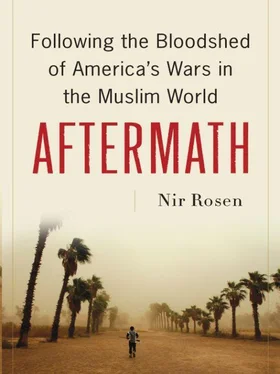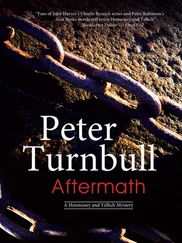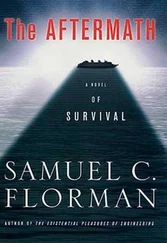Before the war, Shaab—and in particular its Ur neighborhood—had been dominated by anti-regime Sadrists. In the 1990s an Iranian agent called Abu Haidar al-Kheiqani had formed a secret armed opposition group along with a former Communist called Muayad al-Mundher. The two lived in Ur. They recruited a young friend called Haitham al-Khazraji, who would become known as Haitham al-Ansari. Haitham had a brother who was a low-level security officer in what was then known as Saddam City (later Sadr City). Haitham’s brother was known as Ali Mustache because of his big mustache and was in charge of arrests there.
Abu Haidar asked Haitham to join the Sadrists in the hawza to act as a spotter and recruiter. Haitham joined and became a cleric, and helped build the Shurufi Mosque in Shaab. (My close friend Firas in Shaab would become Haitham’s assistant, driver, and bodyguard.) He issued fatwas in support of low-level acts of resistance. He would permit a car to be stolen if it was used against the regime. He would permit a woman to take off her hijab and sit in a car with a man who wasn’t her husband if it helped an anti-regime operation. One time, a female operative sat in a car with a male operative who pretended to be drunk; they got into a fake accident, ramming into an intelligence officer. In the fight that ensued, the officer was shot to death.
Abu Haidar’s group is also said to have killed Haji Falah, the head of intelligence in Saddam City, and it was tied to the attempted assassination of Saddam’s son Uday. Haitham was said to be personally secular, but he saw religion as the only means to combat Saddam’s regime. In about 1998 the Baathists banned Friday prayers in Shurufi Mosque. A riot broke out, and two people were arrested. Others threw stones at security cars.
In about 1998 Abu Haidar, Muayad, and Haitham were all arrested. Abu Haidar and Muayad were executed. Haitham convinced his interrogator, a Sunni from the Dulaimi tribe, that he was just a friend of the other two; he was released after he agreed to work for Iraqi security. But he fled to Jordan, where he became the caretaker for the Jaafar Al Tayar shrine in Karak, the main Shiite shrine in that country. He also sold trinkets on the street and was the only Shiite cleric in Jordan.
In Jordan Haitham was recruited by Ahmad Chalabi’s Iraqi National Congress. Haitham’s role for the INC was to recruit Sadrists. He told the INC that he would not engage in military operations for them, but he secretly involved himself in small-scale acts of sabotage, using the money the INC gave him, which in those three years was not more than thirty thousand dollars. He met officials from the American Defense Intelligence Agency, who sent Thoraya satellite phones to his network in Iraq in exchange for intelligence about the Iraqi Security Forces. Right before the war, Iraqi security realized that Haitham was running spies in Iraq and arrested and tortured some of his people. Nonetheless, Haitham had strong ambitions in the run-up to the U.S. invasion. He proposed moving his operations to western Iraq—principally the Anbar province—but CIA officials rejected this plan, because they had authorized that area for their own man, Ayad Allawi. On April 11, 2003, two days after Baghdad fell, Haitham returned to Ur, linking up with survivors of his network and the renascent Sadrist movement.
Haitham didn’t respect Muqtada and the old guard, and at first he joined the ranks of Muqtada’s rival, Ayatollah Muhammad al-Yaqoubi. But he was quickly disenchanted and soon rejoined Muqtada. All the while he was also collaborating with Chalabi’s INC. Haitham was friends with two other low-level Sadrists from Ur, Ali al-Lami and Jawad al-Bolani; he introduced them to Chalabi, giving their careers a huge boost.
After the war Haitham set up the Tawhid (Unity) association in Ur. In its building Bolani and Lami had offices, as did a former anti-Saddam activist from the southern marshes named Karim Mahud al-Muhammadawi, known as Abu Hatem, or the prince of the marshes, who would go on to lead Iraqi Hizballah. The Tawhid association became an important center. Shiite politicians would visit it; even the American military came. People returned stolen goods to Tawhid, and it had a religious school for women.
After I went over several hundred of the many thousands of documents I found in the looted security station in Baghdad (see chapter one), I gave them to my friend Firas ,and he, in turn, gave them to the Tawhid. Firas drove Haitham to his weekly meetings with Chalabi in Mansour. Falah Hassan Shanshal, who would go on to head the Sadrist bloc of Parliament, would also come to the meetings. Haitham brokered a meeting in a Sadr City mosque between Muhammadawi, Lami, and Bolani. Muhammadawi was seeking local Baghdad representatives and had appointed Bolani and Lami as his local first and second deputies. When Chalabi asked his old friend Haitham to introduce him to local Shiite politicians who could reach into Shiite communities, Haitham introduced him to Lami and Bolani. Together they established an umbrella political group, the Shiite House. The Shiite House became the Shiite Political Council and eventually the Iraqi National Alliance, the main Shiite list in the elections. In late summer 2004, when the Iranians started working with the Sadrists, Haitham was invited to Iran. But the meeting was postponed, and he never made it.
After the war, Sadrists took over a Baath Party office in Ur and turned it into a husseiniya (Shiite place of worship). It was originally controlled by Ayatollah Yaqoubi’s Fadhila organization. Haitham helped oversee the Mustafa Husseiniya, and when he fell out with Yaqoubi he transferred it to Muqtada’s followers. In the summer of 2004, Haitham helped establish a local death squad in the Mustafa Husseiniya. Its men targeted Wahhabis and “terrorists.”
When the IGC set up its de-Baathification office, Muhammadawi appointed Lami the managing director of the archives department, which housed all the documents that contained background information on Baath Party suspects. (Bolani and Lami apparently despised each other and parted company.) When Chalabi suffered total defeat in the 2005 elections, he grew closer with Lami and grew to depend on him. Chalabi used Lami’s bodyguards because they had a fearsome reputation for their skill, and their special privileges allowed them to arrest anybody they accused of being a former Baathist.
Chalabi and Lami visited Iran together often. Both men were sectarian and felt that Shiites had been deprived of their rights in the past. This time they would make sure Shiites took over. Lami became known as Ali Faisal and would run de-Baathification. He hated Baathists and bore a grudge against Sunnis because of his past as a poor Shiite from the slums of Ur. He had lists of Baathists he wanted to dismiss and was determined to purge the Shiite ex-Baathists who had been rehabilitated by the Supreme Council and were protected by it. Meanwhile, Bolani was working with Muhammadawi but looking for other jobs. For a man who would go on to accrue huge political power at the Interior Ministry, he didn’t seem to be picky then. He applied for a job as a flour mill manager, but Chalabi adopted Bolani and took him to Washington in 2004, thus giving him his international profile.
On December 31, 2004, Haitham was killed near his house by a local Shaab terrorist group. Passions were further inflamed with the attempted assassination of Muhammadawi, whose car was shot at as he left the funeral.
Muqtada’s deputy Sheikh Safaa al-Tamimi decided to avenge Haitham’s assassination and established a special assassination squad under his command. All his men belonged to the Mahdi Army, and all their targets belonged to the Salafi movement. A room inside the Mustafa Husseiniya was used for torturing suspects until they confessed. Confessions were filmed, and some included executions of prisoners who admitted to attacking Shiites or civilians. Only the prisoner was shown in the film, with the interrogator in the background calmly asking questions in a southern Iraqi accent (the same one common in Sadr City). Some films showed groups of prisoners sitting together. One such film showed the group that confessed to the murder of Haitham. These snuff films were kept in Sheikh Safaa’s possession and were not reproduced, saved as evidence that only people who deserved it were executed.
Читать дальше











